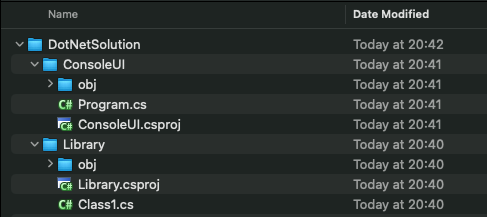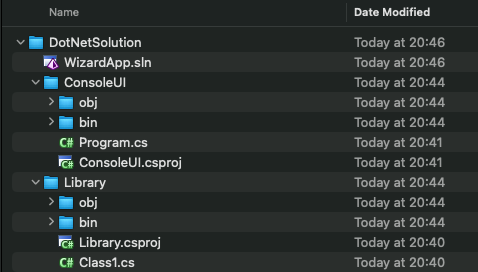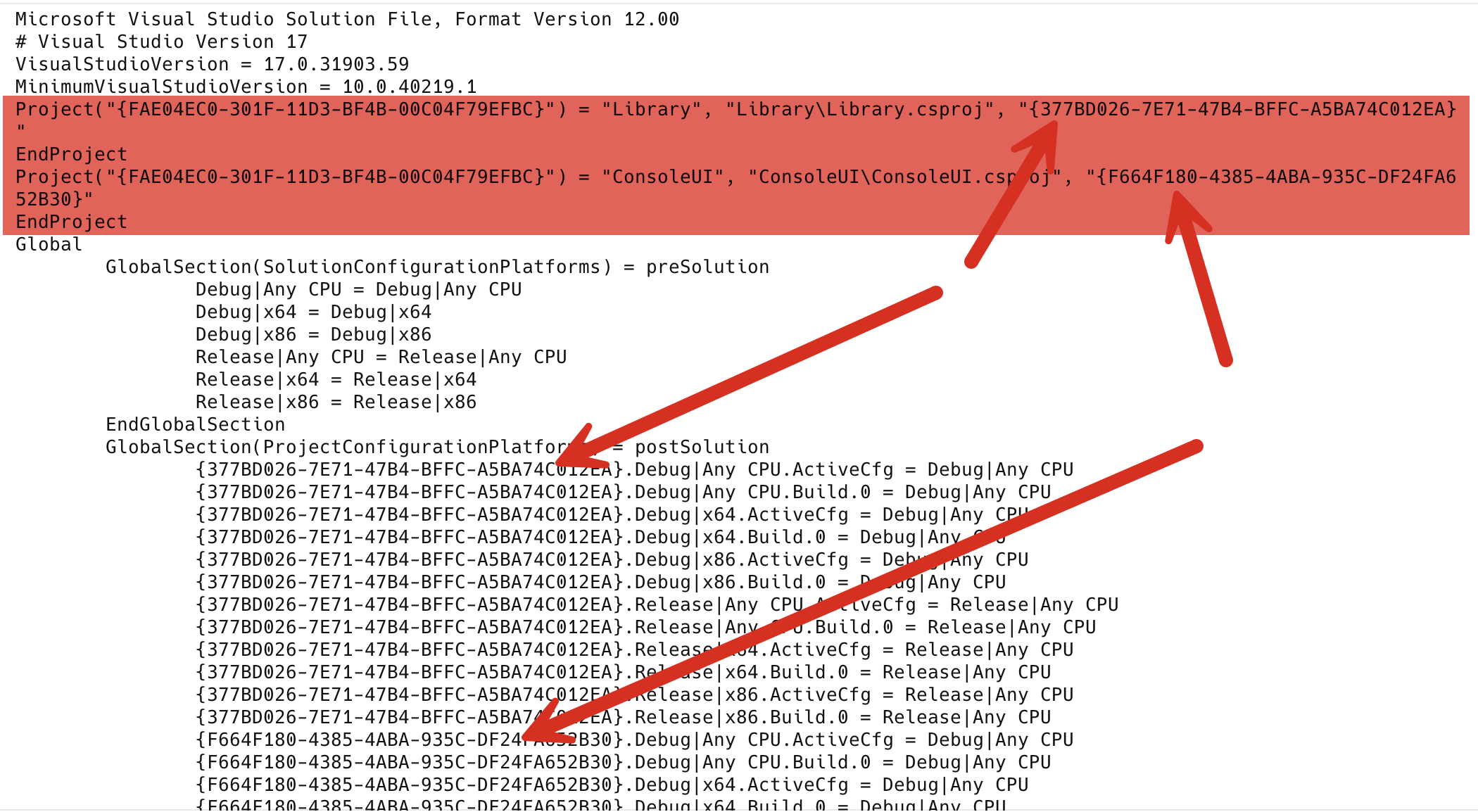Organizing .NET Projects With Solutions
[.NET, Visual Studio]
Whenever you create a .NET application, one of the essential files created is the project file. In C#, it is named xxxx.csproj; in VB.NET, it is named xxxx.vbproj; and in F#, it is named xxxx.fsproj.
This file contains key information for the compiler:
- Project type - executable, class library, etc
- Referenced projects
- Referenced nuget packages
- Project metadata - assembly name, namespaces, etc.
Most of the time, this is sufficient.
But sometimes, you want to manage multiple projects as a unit. The solution helps in this scenario.
Let us start by creating an empty folder in which to store our code:
mkdir DotNetSolution
We then change into this directory and create a blank class library
dotnet new classlib -o Library
Next, we create a console application
dotnet new console -o ConsoleUI
Our folder structure now looks like this:

If we wanted to build both of these, we would need to do it with two commands:
dotnet build Library/Library.csproj
dotnet build ConsoleUI/ConsoleUI.csproj
A solution can help in this situation.
The first step is to create a blank solution using the dotnet new sln command.
From within the current directory, type the following:
dotnet new sln
This solution will take the name of the current folder.
You can also change it to whatever you want using the -n switch
dotnet new sln -n WizardApp
The file structure is now as follows:

What is in the WizardApp.sln file? It is actually text and can be viewed as follows:
cat WizardApp.sln
This will return the following:
Microsoft Visual Studio Solution File, Format Version 12.00
# Visual Studio Version 17
VisualStudioVersion = 17.0.31903.59
MinimumVisualStudioVersion = 10.0.40219.1
Global
GlobalSection(SolutionConfigurationPlatforms) = preSolution
Debug|Any CPU = Debug|Any CPU
Release|Any CPU = Release|Any CPU
EndGlobalSection
GlobalSection(SolutionProperties) = preSolution
HideSolutionNode = FALSE
EndGlobalSection
EndGlobal
Currently, it is essentially empty.
We need to add projects to the solution.
This is done using the dotnet sln add command, which takes a project file (csproj,vbproj or fsproj) as a parameter.
dotnet sln add Library/Library.csproj
This will print the following:
Project `Library/Library.csproj` added to the solution.
Similarly, for the console application:
dotnet sln add ConsoleUI/ConsoleUI.csproj
The following will be printed
Project `ConsoleUI/ConsoleUI.csproj` added to the solution.
Now, if we run dotnet build from the current directory:

We can see here that both of the projects were built successfully.
If we now examine the contents of the sln file:
Microsoft Visual Studio Solution File, Format Version 12.00
# Visual Studio Version 17
VisualStudioVersion = 17.0.31903.59
MinimumVisualStudioVersion = 10.0.40219.1
Project("{FAE04EC0-301F-11D3-BF4B-00C04F79EFBC}") = "Library", "Library\Library.csproj", "{377BD026-7E71-47B4-BFFC-A5BA74C012EA}"
EndProject
Project("{FAE04EC0-301F-11D3-BF4B-00C04F79EFBC}") = "ConsoleUI", "ConsoleUI\ConsoleUI.csproj", "{F664F180-4385-4ABA-935C-DF24FA652B30}"
EndProject
Global
GlobalSection(SolutionConfigurationPlatforms) = preSolution
Debug|Any CPU = Debug|Any CPU
Debug|x64 = Debug|x64
Debug|x86 = Debug|x86
Release|Any CPU = Release|Any CPU
Release|x64 = Release|x64
Release|x86 = Release|x86
EndGlobalSection
GlobalSection(ProjectConfigurationPlatforms) = postSolution
{377BD026-7E71-47B4-BFFC-A5BA74C012EA}.Debug|Any CPU.ActiveCfg = Debug|Any CPU
{377BD026-7E71-47B4-BFFC-A5BA74C012EA}.Debug|Any CPU.Build.0 = Debug|Any CPU
{377BD026-7E71-47B4-BFFC-A5BA74C012EA}.Debug|x64.ActiveCfg = Debug|Any CPU
{377BD026-7E71-47B4-BFFC-A5BA74C012EA}.Debug|x64.Build.0 = Debug|Any CPU
{377BD026-7E71-47B4-BFFC-A5BA74C012EA}.Debug|x86.ActiveCfg = Debug|Any CPU
{377BD026-7E71-47B4-BFFC-A5BA74C012EA}.Debug|x86.Build.0 = Debug|Any CPU
{377BD026-7E71-47B4-BFFC-A5BA74C012EA}.Release|Any CPU.ActiveCfg = Release|Any CPU
{377BD026-7E71-47B4-BFFC-A5BA74C012EA}.Release|Any CPU.Build.0 = Release|Any CPU
{377BD026-7E71-47B4-BFFC-A5BA74C012EA}.Release|x64.ActiveCfg = Release|Any CPU
{377BD026-7E71-47B4-BFFC-A5BA74C012EA}.Release|x64.Build.0 = Release|Any CPU
{377BD026-7E71-47B4-BFFC-A5BA74C012EA}.Release|x86.ActiveCfg = Release|Any CPU
{377BD026-7E71-47B4-BFFC-A5BA74C012EA}.Release|x86.Build.0 = Release|Any CPU
{F664F180-4385-4ABA-935C-DF24FA652B30}.Debug|Any CPU.ActiveCfg = Debug|Any CPU
{F664F180-4385-4ABA-935C-DF24FA652B30}.Debug|Any CPU.Build.0 = Debug|Any CPU
{F664F180-4385-4ABA-935C-DF24FA652B30}.Debug|x64.ActiveCfg = Debug|Any CPU
{F664F180-4385-4ABA-935C-DF24FA652B30}.Debug|x64.Build.0 = Debug|Any CPU
{F664F180-4385-4ABA-935C-DF24FA652B30}.Debug|x86.ActiveCfg = Debug|Any CPU
{F664F180-4385-4ABA-935C-DF24FA652B30}.Debug|x86.Build.0 = Debug|Any CPU
{F664F180-4385-4ABA-935C-DF24FA652B30}.Release|Any CPU.ActiveCfg = Release|Any CPU
{F664F180-4385-4ABA-935C-DF24FA652B30}.Release|Any CPU.Build.0 = Release|Any CPU
{F664F180-4385-4ABA-935C-DF24FA652B30}.Release|x64.ActiveCfg = Release|Any CPU
{F664F180-4385-4ABA-935C-DF24FA652B30}.Release|x64.Build.0 = Release|Any CPU
{F664F180-4385-4ABA-935C-DF24FA652B30}.Release|x86.ActiveCfg = Release|Any CPU
{F664F180-4385-4ABA-935C-DF24FA652B30}.Release|x86.Build.0 = Release|Any CPU
EndGlobalSection
GlobalSection(SolutionProperties) = preSolution
HideSolutionNode = FALSE
EndGlobalSection
EndGlobal
The magic is happening here, where each project is assigned a Guid that is used to set some build configurations.

Let us now create a new test project:
dotnet new xunit -o Tests
We then add this to the solution:
dotnet sln add Tests/Tests.csproj
We can now see our sln is updated.
Microsoft Visual Studio Solution File, Format Version 12.00
# Visual Studio Version 17
VisualStudioVersion = 17.0.31903.59
MinimumVisualStudioVersion = 10.0.40219.1
Project("{FAE04EC0-301F-11D3-BF4B-00C04F79EFBC}") = "Library", "Library\Library.csproj", "{377BD026-7E71-47B4-BFFC-A5BA74C012EA}"
EndProject
Project("{FAE04EC0-301F-11D3-BF4B-00C04F79EFBC}") = "ConsoleUI", "ConsoleUI\ConsoleUI.csproj", "{F664F180-4385-4ABA-935C-DF24FA652B30}"
EndProject
Project("{FAE04EC0-301F-11D3-BF4B-00C04F79EFBC}") = "Tests", "Tests\Tests.csproj", "{8D3A15BA-6953-4FB7-BF97-B90366B886E0}"
EndProject
-- The rest trimmed out
We can also remove projects from a solution, using the dotnet sln remove command
dotnet sln remove Tests/Tests.csproj
This will print the following:
Project `Tests/Tests.csproj` removed from the solution.
It is strongly discouraged to directly manipulate this file manually.
You can also list all the projects in a sln file
dotnet sln list
This will print the following:
Project(s)
----------
ConsoleUI/ConsoleUI.csproj
Library/Library.csproj
Finally, having more than one solution file for your own reasons is also possible. Perhaps one will include the test projects, and the other won’t.
In this scenario, pass the solution name as a parameter when building.
dotnet build WizardApp.sln
TLDR
When handling software projects with multiple projects, it is beneficial to organize them into solution (sln) files.
The code is in my GitHub.
Happy hacking!